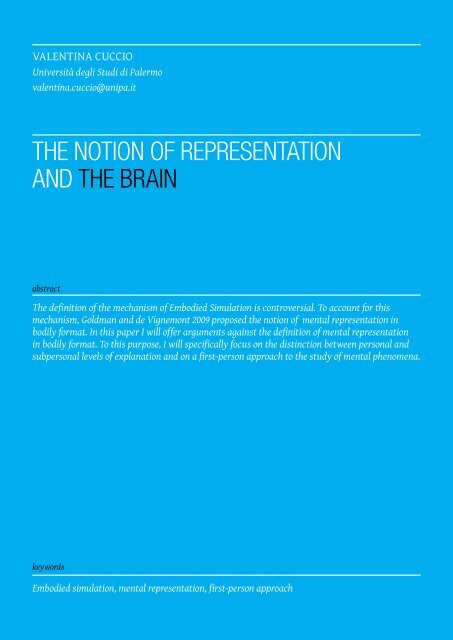A4_PHEN-MIND_n7
A4_PHEN-MIND_n7
A4_PHEN-MIND_n7
Create successful ePaper yourself
Turn your PDF publications into a flip-book with our unique Google optimized e-Paper software.
Valentina Cuccio<br />
Università degli Studi di Palermo<br />
valentina.cuccio@unipa.it<br />
The Notion of Representation and the Brain<br />
The Notion of Representation<br />
and the Brain<br />
abstract<br />
The definition of the mechanism of Embodied Simulation is controversial. To account for this<br />
mechanism, Goldman and de Vignemont 2009 proposed the notion of mental representation in<br />
bodily format. In this paper I will offer arguments against the definition of mental representation<br />
in bodily format. To this purpose, I will specifically focus on the distinction between personal and<br />
subpersonal levels of explanation and on a first-person approach to the study of mental phenomena.<br />
keywords<br />
Embodied simulation, mental representation, first-person approach<br />
1.<br />
Introduction<br />
The term representation is, perhaps, one of the most contested expressions in the history of philosophy.<br />
Hundreds of pages would not suffice to summarize all of the different definitions and usages it has<br />
undergone in centuries of philosophical inquiry. Thus, my aim here must be far more limited. I will<br />
focus on some usages of this notion in the field of embodied cognition. Even in embodied cognition<br />
studies, the notion of representation has been seen in very different lights. Radical enactivists claim<br />
that we should get rid of this notion altogether, while many other supporters of embodiment believe<br />
that how the mind works cannot be explained without it. In fact, the use of the notion of representation<br />
in theories about human cognition has been considered as a demarcation line between radical and<br />
less radical embodied theorists (this distinction was introduced by Clark 1997; see also Chemero 2009;<br />
Alsmith & de Vignemont 2012). On one hand, radical embodied theorists claim that we can explain<br />
how the human mind works without resorting to mental representations (Kelso 1995; Port & van<br />
Gelder 1995; Thelen & Smith 1994; van Gelder 1995; Chemero 2009); on the other hand, exponents of<br />
moderate embodiment propose theories that include both representational and not representational<br />
explanations of human cognition (Barsalou 1999, 2008; Clark, 1997; Gallese & Sinigaglia 2011; Goldman &<br />
de Vignemont 2009).<br />
I will not analyze all of the usages representation has undergone in embodiment literature here. Instead,<br />
I will focus on a more specific problem: to what extent can we define the mechanism of Embodied<br />
Simulation in terms of mental representations Embodied Simulation is the activation of specific neural<br />
circuits of the brain that control actions, perceptions, the experiencing of bodily states or emotions<br />
when a person is not actively engaged in those actions, perceptions, bodily states or emotions. To give<br />
an example, the motor areas in my brain that control the action of grasping a cup will be activated not<br />
only when I effectively grasp a cup but also when I see a cup, when I observe someone else grasping a<br />
cup, when I read or listen to a proposition about someone grasping a cup or when I just imagine someone<br />
grasping a cup.<br />
Today, the question about the legitimacy of the definition of the mechanism of Embodied Simulation in<br />
terms of mental representation is very urgent. The characterization of this mechanism in the current<br />
debate is quite controversial and, as a consequence, the definition of its role in human cognition is also<br />
quite controversial (see Mahon & Caramazza 2008 for a deeper discussion of this point).<br />
In a recent paper, Goldman and de Vignemont (2009) proposed the notion of mental representations in<br />
185



